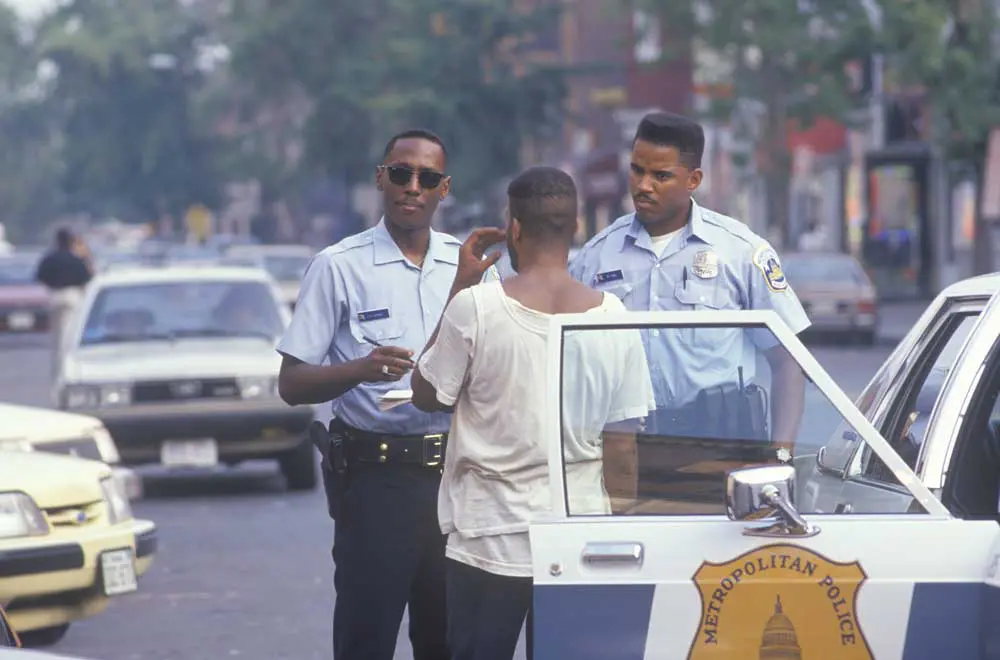Photograph by Joseph Sohm / Shutterstock.com
Years ago, during a debate, then-Senator Barack Obama claimed that blacks and whites are arrested and convicted at very different rates, and even receive very different sentences for the same crimes. Senator Hillary Clinton then discussed the “disgrace of a criminal justice system” that incarcerates a disproportionate number of African-Americans as compared to whites. These statements appear fairly plausible for the time, considering in 2006 37.5 percent of all state and federal prisoners were African-American. Further about one in 33 African-American men was incarcerated in 2006, compared to one in 205 white men, and one in 79 Hispanic men.
This particular year’s statistics also include the staggering fact that eleven percent of all black males between the ages of 20 and 34 are in prison or jail. The question then becomes whether African Americans make up a disproportionate share of those in prison and jail because they commit more criminal offenses, or whether there is definite racial bias present, alive and well in the American system of criminal justice. Since Barack Obama and Hillary Clinton were having this discussion nearly a decade ago, the issue has reached even more heated debates following the Ferguson Missouri incident, and the many that have followed.
What is Responsible for Racism in Our Criminal Justice System?
While there are any number of factors involved in the racism seen in our criminal justice system, some believe at least one of those factors has to be that African American men simply commit more crimes than other races. Between 1976 and 2005, blacks committed more than 52 percent of all the murders in America. Yet, many others believe that police officers, judges and juries treat blacks and whites differently for the exact same crime.

Request a Free Consultation
In other words, blacks are over-arrested, while white criminals are more likely to be ignored. And, despite the fact that there has never been a single plausible explanation for this fact, research has shown time and time again that even crime victims tend to be biased in their reports—there is a parity between the assailant’s race and victim ID’s.
Are Unfair Drug Policies to Blame?
Another popular explanation for the high incarceration rates of blacks, hinges on unfair drug policies. Activists and academics claim the “war on drugs” is nothing more than a war on minorities. Backing up this theory are the significant differences in sentencing between possession of crack and the possession of powder cocaine—essentially the same drug, yet typically used differently from one race to another. Crack is a highly addictive form of cocaine, which is created by cooking powder cocaine until it hardens into “rocks.” Crack produces a more potent—and faster—high than powder cocaine, and is often the drug of choice for African Americans. Whites, on the other hand, are more likely to snort powdered cocaine.
While on the surface, this seems no more relevant than the fact that many Southerners like grits, while those further north tend to prefer hash browns, the relevance lies in the federal sentencing for each form of the drug. Under the 1986 federal Anti-Drug Abuse Act, possession of five grams of crack brings a five-year mandatory prison sentence. To trigger the same sentence, a person would have to be in possession of 500 grams of powder cocaine. In fact, the federal sentences for crack cocaine are about 3-6 times longer than the sentences for equivalent amounts of powder cocaine. Going back to 2006 drug statistics, about 81 percent of all federal crack cocaine defendants were African American.
Remember, these statistics come from federal drug crimes. In 2006, only 13 states distinguished between crack cocaine and powder cocaine sentences, yet there remained a disproportionate number of African Americans imprisoned for state drug crimes. Further, federal methamphetamine trafficking penalties are identical to those for crack, and in 2006, 54 percent of those sentenced for meth were white, 39 percent were Hispanic, and only two percent were black—leading one to wonder whether the war on drugs is as racist as it first appears.
One in Four African-American Males Born This Decade Can Expect Prison in the Future
A decade after the statistics quoted above came about, the Huffington Post claimed racism could be the “biggest crime in the criminal legal system,” and that one in every four African-American males born this decade, can expect to find themselves imprisoned during their lifetime. Current census reports show African Americans still make up only 13 percent of the population, with whites making up 61 percent and Hispanics making up 17 percent. Today, black men are about 6 times as likely to be incarcerated as white men—according to some, this is because there is a deep racism “built into every step of the criminal legal system.” The statistics backing up the statements made in the Huffington Post article include the following:
- African American men are stopped at twice the rate of white men.
- When it comes to police searches, once stopped, about three times as many African American and Hispanic drivers are searched as white drivers.
- Physical force is also much more likely to be used against African Americans—in particular, pepper spray, dogs and tasers are much more likely to be used against African Americans than against whites, although there is the school of thought that says at least some of the use of physical force is in response to unruliness by the suspect. Many of the cases we have seen over the past few years seem to show otherwise.
- Even young African Americans face these biases—as far as curfew violations, black teens are 2.5 times as likely to be arrested than white teens.
- Marijuana arrests are disproportionately made against African Americans—blacks are 3.73 times as likely to be arrested for marijuana possession even though self-reporting says the use of marijuana is roughly similar between whites and blacks.
- African Americans are at least twice as likely to receive a mandatory minimum sentence than whites who have been accused of the same crime.
- African Americans are also much more likely to spend more time in prison than whites—African American men receive sentences which are nearly 20 percent longer than white men convicted of the same crime.
- Black women appear to have the same high rates of incarceration as men, as they are incarcerated at a rate which is almost three times as high as that of white women.
- Once imprisoned, white prisoners are much more likely to be paroled for non-violent offenses than black prisoners—nearly 65 percent of those serving life without parole for a non-violent offense are black.
- The disparities do not end in prison. Of course, we are all aware that having a criminal record can make employment difficult, however these difficulties are even more intense for African-American men. White men with a criminal history are more likely to receive a positive response during their job search than black men with no criminal history.
- One out of every thirteen African Americans no longer has a right to vote due to felony incarcerations (For non-blacks, that number is one out of every 56).
Life After Life
The journey of three black men who returned to their homes after incarceration in the San Quentin State Prison, titled “Life After Life,” painfully illustrates the racism which dominates the American criminal justice system. In 2006, Tamara Perkins began her journey, with more than 250 hours of footage from those incarcerated at the California prison. Perkins believes that “trauma, addiction, violence, poverty and racism…” rendered the African American men whose lives she followed for ten years “murderers and monsters,” in the eyes of society.
In reality, Perkins believed the extraordinarily difficult childhoods of these men were to blame for their incarceration, claiming we place people in poverty, then criminalize them. The three men Perkins specifically followed spent 61 years behind bars, then were released on parole for four years each. Perkins believes that for these men, creating a new life in a world where there is virtually no support and understanding can be almost impossible.
Perkins believes the roles of race and bias cannot be understated, since black children are four times as likely to be suspended from preschool than white children. Think carefully about this statistic. As early as age four, black children may already be the subject of bias and racism in school. In yet another study done on the teachers of these children, while some of the teachers who were aware of a black child’s tough home life exhibited some increase in empathy, others—who were equally aware of the child’s home life—actually exhibited increased punitive actions toward the child. The researchers could find no good explanation for this, other than racial bias.
Racial Origins of Policing in America
If you are searching for the “why” of the racism in our criminal justice system, an article by Black Enterprise traces it back to the time when patrollers, or police, punished black slaves traveling without a permit, captured runaway blacks, and “disciplined” rebellious black slaves. These so-called “slave patrols” evolved into an “informal system of vigilantism designed to preserve white supremacy, discourage social and economic progress and weaken the black political establishment.” Even in the 1940’s and 1950’s, law enforcement openly joined the Ku Klux Klan. While most of us want to believe that is far in the past, a recent FBI investigation revealed two police officers were active members of the KKK.
Racism, Surveillance and a Society Which Creates Problems and Barriers for Black People
Rebecca Roberts, with the Centre for Crime and Justice Studies, explored the “disproportionality” of our criminal justice system. Roberts claims that black people experience problems—they are not the problem. Roberts places young Muslim men in roughly the same category as young black men, noting that Muslim prisoners now account for 13.4 percent of the prison population, compared to 4.2 percent in 2011. While in prison, both black and Muslim men were subject to higher rates of adjudication, spend more days in segregation, and are more frequently subjected to the use of force by prison guards.
Roberts also notes that while most of us believe that the most dangerous individuals in society are placed in prison by the criminal justice system, this is not always the case, and that the racism in our criminal justice system is not just a problem of police and criminal justice. In other words, our policing organizations do not operate in a bubble—they are driven by outside factors. Most particularly, these outside factors include that young black men, and, increasingly, young Muslim men, are identified as “different,” or “dangerous,” therefore experience an increase of barriers in their life.
Where Do We Begin to Address Racism in Our Criminal Justice System?
Social justice is irrevocably intertwined with criminal justice—the police must first be held accountable, both as an institution and individually. Many believe police departments should merge with fire, ambulance and community health services to more fully protect and support communities. While this may or may not be a solution to racism in our criminal justice system, the fact remains that if nothing is done, the situation will only get worse. Social justice can tackle racism, inequality and discrimination through helping those communities which need it the most, as well as criminal justice reform which requires us to be highly informed about our past, yet ambitious and optimistic about the future. The system must be challenged, and the problems clearly identified in order to resist racism in the criminal justice system, building both short and long-term solutions to the problem.

